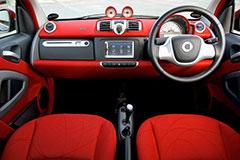Rules for Picking Car Interior Color - Vol.361
When thinking about car colors, almost immediately, everyone thinks of the colors for the exterior of the car. And that's quite understandable, since that's the first thing everyone's going to notice. A nice, eye-catching color can make your car very attractive, even if you own an older car. And if it's done particularly well, it can even make your car look much more expensive than it really is. Not to mention the further customization, such as adding vinyl wraps and other visual enhancements, which can really make all the difference.

But what about the interior? Do we really think a lot about picking a car interior color? Well, apparently not. Most people just stick with what comes with their car. And there's usually a fixed range of colors that are offered with each vehicle. Those will usually include black, white or gray, or maybe tan. A wider selection of interior colors is usually available for more luxurious vehicles, but obviously, those are much more expensive, and such level of customization is expected when you pay a lot of money for a car.
So, you might be thinking - what are some rules for picking the car interior color? Well, it's not exactly written in stone. There isn't only one rule that everyone has to abide by. Common sense would be to stick with what you think works best for you, but you have to keep in mind that picking a car interior color isn't just a matter of personal preference and aesthetics. There are actually some quite practical benefits (as well as drawbacks) to each car interior color.
Take, for example, black. It's one of the most common colors you see in car interiors. It goes well with all exterior colors, so it seems like a safe option. However, if you go back to elementary school science classes, you'll recall that black absorbs most light, and traps the heat. And if you don't have A/C, and don't happen to live in a particularly good climate, that's not very good news. However, what is good about black interiors is that this color hides the actual dirt best. On the other hand, it will show the superficial dirt more, such as dust and lint.
On the other side of the color spectrum, we have white. White interiors have an advantage over black ones, as they won't absorb the heat that much. Plus, it will make the car look more elegant. However, it won't do such a good job hiding stains, and if you're a particularly messy person, of have little kids, white is probably not a good idea.
Other common options include gray and tan, which seem like a good middle ground solution if you can't make your mind up between black and white. Gray is a good choice for those who want to still be able to hide dirt, and have a lighter interior that goes well with the overall design of the car.
Of course, you're not just limited to a handful of color options for the interior of you four-wheeler. Buyers of more expensive, luxurious cars have the option to choose between dozens of colors. And even if you're not interested in buying a luxury vehicle, you can actually change the interior of your existing car by simply changing the color of the upholstery. This gives you a wide selection and freedom of choice, limited only by your imagination. One thing to keep in mind, and what could be a guideline or a rule, is to choose a color that's complementary to your car's exterior. If you're not sure what color best complements your car's exterior, there are helpful online tools such a Color Calculator which let you easily figure out what colors go well together, making the decision easier.